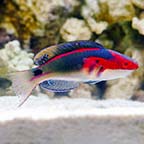

Additional locales and sizes may be available!
Additional locales and sizes may be available! Email me when availableQuick Stats
What do these Quick Stats mean? Click here for more information
What do these Quick Stats mean? Click here for more information
Overview
The Squamosa Clam, Blue is also referred to as the Scaled Clam. Its species name squamosa is the Latin word for scale. The numerous rows of large scales over its entire shell are often used as shelter by other organisms, such as small crabs, other clams, and other invertebrates. The shell is symmetrical, and the matching growth pattern in its shell allows it to close together very tightly when it needs to. The Squamosa Clam is often found living amongst Acropora coral, anchored by its byssal filaments. It has a wide byssal opening and long tentacles surrounding its incurrent siphon. The Squamosa Clam can grow up to 12 inches or larger in the home aquarium.
The Squamosa Clams require intense lighting to thrive as they contain the symbiotic algae called zooxanthellae, and receive the majority of their nutrition from the light through photosynthesis. Care should be taken to properly photo-adapt Squamosa Clams to the existing reef aquarium lighting in a similar manner to newly introduced stony and soft corals. When adapting a new Squamosa Clam to very intense lighting, it is ideal to set them on a small rock or in a plastic dish with coarse substrate at the bottom of the aquarium. Over time, the clam can then be slowly moved up higher in the aquarium.
The Squamosa Clam relies heavily on the photosynthesis of the zooxanthellae cells growing in its mantle. However, all clams also require micro foods designed for filter feeders, especially when small. Offer phytoplankton and other micro-foods.
We recommend:
AlgaGen Acartia tonsa
AlgaGen Pseudodiaptomus pelagicus
AlgaGen Parvocalanus crassirostris
AlgaGen PhycoPure™ Reef Blend
AlgaGen Decap'd Brine™
AlgaGen Rotifers











